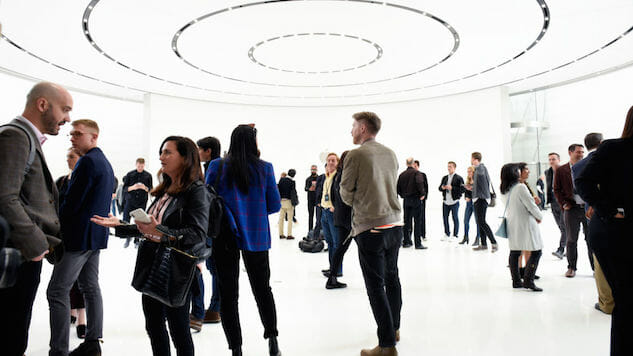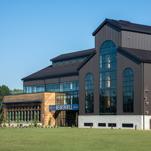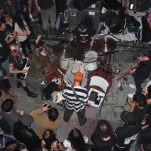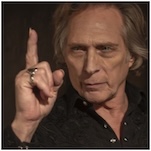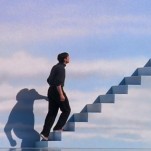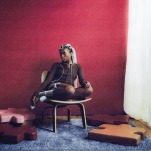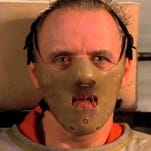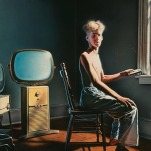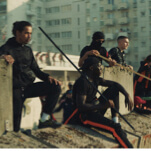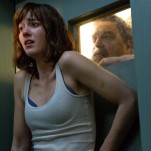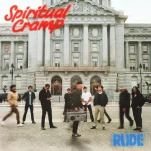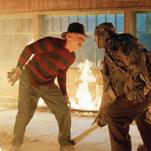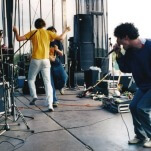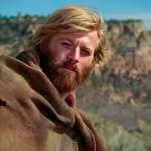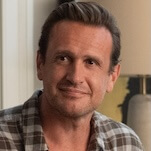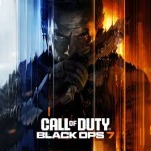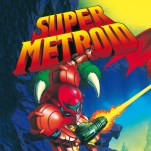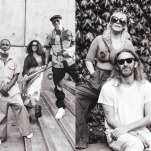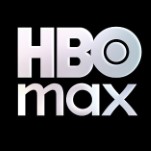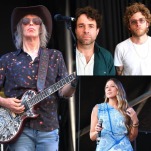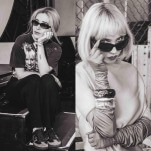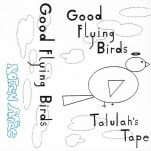It’s a blustery, gray morning in Silicon Valley, and the excitement is palpable. Insistent, in fact: Disembarking from a hulking shuttle near the entrance to Apple Park, I’m met by a battalion of enthusiasts, an Apple employee in a puffy black jacket with a seafoam-green logo on the breast greeting me every 20 feet. One reassures me that there’s no limit on photographs. Another describes the architectural feat by which the roof of the Steve Jobs Theater was set atop its walls, neglecting to mention that the structure is a circular glass fish tank lidded with a dinner plate. A third compliments my beard; a fourth asks to photograph me. That this is too much is incontestable. The theater is at most a 7-minute walk from the entrance, with a sleek “visitor center”—read: Apple store—in between, and the #AppleEvent I’m here to cover—”It’s show time,” the invitation read—doesn’t begin for another 90 minutes. If there were any danger of getting lost amid the mulched hillsides, perfectly manicured grass, and plumb lines of trees, I’d find my way back before the footlights dimmed. And so I’m left to consider why, repeating the question until the inside of my head has the ring of that old Enron spot. Why is a brand built on a certain distracted cool selling me so hard? Why does the familiar corporate desire to control the message suddenly feel like a death grip? Why must the launch of what amounts to a new TV network come with this “forced fun” aspect, as grim in its determination to please as a costumed character at Disney World or a server at Chuck E. Cheese? Before I enter the theater, I stop for a selfie (well, two; being vain, I delete the first) and a snap of the building’s façade to start my Twitter thread on the day’s presentation: I, too, am part of the machine—a skeptic, perhaps, though no conscientious objector—and Apple knows that it is becoming harder and harder to hold my attention.
That this is too much is also the point.
8:44 a.m.
Inside the gleaming lobby of the Steve Jobs Theater, the noise is rising. Deafening, in fact: The sound of hundreds of journalists, entertainment industry figures, and Apple employees milling about with pour-over coffees and fancy pastries generates the same whir as a prop plane, which is à propos given the room’s “airport terminal” aesthetic. I know almost no one here, and even fewer know me, so until I spot a pair of familiar faces from my college daily, I’m left to scroll Twitter and scrawl notes in a green memo pad stuffed into my back pocket.
As I dutifully record the “telling” details—waiters circulating with wooden trays of brightly hued juices; bloggers holding their phones in tense, outstretched arms, recording the scene over their own shoulders—it occurs to me that the waiting is part of the machine in question, the turning gears of anticipation kneading us into a more pliable state. As if on cue, an inexplicable wave of applause rolls through the crowd, then another: Hype emanating from an unknown source, only to dissipate just as quickly. It’s a fair metaphor for the tech sector, the country, the modern age, in which common features of the socioeconomic landscape are repackaged as technological “innovations.” Remember when Bodega invented the vending machine, and Elon Musk did the same for the bus stop? Remember the promises of “Uber for” housekeepers, car washes, errand boys, parking spots? Even the casual observer might see the post-industrial economy as a series of phantoms—ghostly outlines of products and services and entire industries we once knew, now chalked in binary code.
Hype works, of course. As Christian Loretzen points out in the April issue of Harper’s, most of what passes for literary criticism is comprised of lists and raves; film culture now largely revolves around the annual ritual of handing out awards. On my own beat, TV, it has become harder and harder to cut through the clutter of 500 original scripted series, countless reality programs, 24-hour cable news, social media chatter, and a vast array of entertainment publications covering the same things at the same times, such that it’s begun to feel like the only way to be read is to collaborate in the production of hype and hope that a flattered star or excited network publicist or zealous brand deigns to amplify it. The occasional masterpiece of real, serious thought sneaks through, along with an illuminating profile or bomb-throwing takedown or deep-dive feature, and yet even these seem to do so primarily in the slipstream of hype, as part of the reaction/counter-reaction/counter-counter-reaction cycle that’s come to define the “discourse.” It’s the digital equivalent of the roar in the lobby of the Steve Jobs Theater. This, too, is the point: As a colleague I run into says when I wonder aloud why Apple instructed us to arrive so early, “When Apple gives you directions, you listen.” And when it is too loud to hear yourself think, what that leaves you is thoughtless.
9:30 a.m.
An exceedingly friendly young woman in a seafoam-green T-shirt tells me, with a wide smile, that no, she cannot point me in the direction of the restroom, as the floor the restrooms are on is now closed until seating begins.
9:36 a.m.
I am definitely regretting that second cup of coffee.
9:40 a.m.
The scrum that’s massed atop the stairs down to the venue—an underground amphitheater with brown-leather seats, or the most opulent man-cave ever built—begins to move, with all the organizational know-how of an airplane boarding sequence. (At this point, I must confess, I’m more hyped not to piss myself in front of the entire press corps than I am to see “Tim Apple” in the flesh, though the line for the restroom means I end up in the nosebleed section.) As I file into my row, Apple Radio plays Khalid’s “Talk,” before the DJ tees up Apple CEO Tim Cook’s opening salvo with “Listzomania”: “We’re turning it over to you, Cupertino, with this classic from Phoenix.” It is, of course, a striking choice. In coining the term “Lisztomania” for the craze surrounding Hungarian composer Franz Liszt, the writer Heinrich Heine described it as “a veritable insanity,” one cultivated by the musician himself: “It seems to me at times that all this sorcery may be explained by the fact that no one on Earth knows so well how to organize his successes, or rather their mise en scène, as Franz Liszt.” In other words, Lisztomania is a response to hype.
10:00 a.m.
That an Apple launch is a corporate Woodstock becomes clearer still when the lights go down, leaving only the ambient glow of smart phones and laptops in the audience—like the wave of flashbulbs that curls and crests around an Olympic stadium before the torch is lit. Over the course of the next two hours, CEO Tim Cook and an array of fellow executives introduce a series of “innovations” to the newsstand, the credit card, the video arcade; later, unveiling its “innovation” to the television network, the company calls on a familiar “cavalcade of stars,” from Steven Spielberg to Oprah Winfrey. The presentation’s organizing principle is Apple’s definition of service—the action of helping or doing work for someone—which raises, in turn, the day’s looming question: Who, here, is working for whom? In reporting on Apple TV+, am I doing a service to my readers, or to Apple? Am I playing the hype man, or the skeptic? Is it possible, anymore, to find the balance between them, to set aside the veritable insanity of the system, its powerful sorcery, long enough to hold a cogent thought?
By way of an answer I can only offer this: Nothing that happens at Apple, a corporation whose market capitalization at the moment I type this is more than $892 billion, can be said to be an accident, and so the most arresting feature of the launch is not what happens on stage. It is the experience of sitting between a man wolf whistling at the Apple Card and a woman with her hands clasped expectantly under her chin, behind the man who notes that he can now cancel his cable and in front of the woman who proclaims, “That was lit,” presumably employees of the corporation in question. It’s not that I believe these people are “plants,” in the traditional sense, with a script designed to pique my interest. It’s that their very presence is an attempt to shape my assessment, and that, of course, it does: If I am sincerely keen on the services in question, I’m at risk of being called a shill, and if I am sincerely critical of those services, I’m at risk of being called a wet blanket. You cannot win for losing is the phrase that comes to mind, though I suppose it’s possible I’m being melodramatic. I, too, am in the business of hype.
1:15 p.m.
I love filing copy on the fly. Hunched over my laptop (a MacBook Air), texting first impressions (on my iPhone) to my assistant editor / sounding board, Amy Amatangelo, racing to publish before anyone else has scooped my central thesis—that Apple TV+ is no game changer—I go into the flow state that I tend to see as the opposite of the roar, the antithesis of hype. I suspect it’s because such moments are more quiet, more honest, it being harder to lie to yourself when you’re listening closely. As soon as I press publish, the doubt returns: Was I fair? (I hope so.) Was I thoughtful? (Maybe.) Did I spell DirecTV right? (As it turns out, no.) I am suddenly back at Apple Park, leaning over a dying computer at a high table, uncertain what to do next. Still, for all my mixed feelings about the launch itself, or indeed the services promised, I am glad for days like this. They remind me why my favorite part of the job is leaning over a dying computer at a high table in my dining room, where the only sound is the trickle of the fountain in my courtyard and the occasional passing truck. The only antidote to a culture of too much is less, less, less: In context it’s never too little. It’s just right.
Matt Brennan is the TV editor of Paste Magazine
. He tweets about what he’s watching @thefilmgoer.